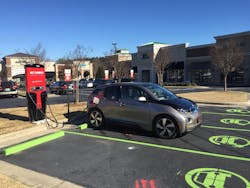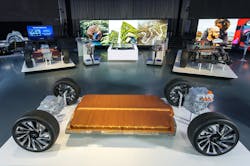As EV Market Heats Up, Utilities Confront Interoperability
Communities around the world are embracing decarbonization goals to improve air quality and address climate change. One way to reduce greenhouse gas emissions is to replace traditional, gasoline-powered cars with electric vehicles (EVs) that use a battery-powered electric motor. Because they burn no gasoline or diesel fuel, EVs have no emissions. By 2050, electrifying all forms of transport in the U.S. could reduce greenhouse gas emissions by 57% compared to 2015 levels, according to the Electric Power Research Institute (EPRI).
In Europe, EVs made up 11.2% of the new-vehicle market in 2020, with Norway leading the pack — at 54%. In China, another growing market, more than 5% of cars sold were EVs. One forecast by the International Energy Agency has the number of EVs on the road surging to 125 million globally by 2030. EPRI anticipates EVs will account for four in 10 new cars sold in 2030. Although U.S. sales increased only slightly in 2020, to 2.1% of the market, the EV horizon in the U.S. looks promising. For instance, General Motors, which expects to sell 1 million EVs per year by 2023, has vowed to build only light-duty EVs by 2035.
President Biden is prioritizing EV research and manufacturing to compete with China’s longstanding effort to dominate global EV production and, through executive order, has called for a plan to convert all federal, state, local and tribal fleets, including U.S. Postal Service vehicles, to clean and zero-emission vehicles.
Solid Public EV Infrastructure
Biden’s executive order follows the example of Amazon, FedEx, UPS and other fleet operators. These companies are purchasing electric delivery vehicles, many for routes of less than 100 miles (161 km), that return at the day’s end for a recharge.
Of course, charging a bus, truck or van fleet can present logistical and technical challenges. Consider a municipality or delivery company that needs to charge 200 vehicles overnight. In many cases, utility investments in new substations, upgraded power lines and other grid infrastructure might be necessary to charge a fleet used for only part or even the bulk of the day.
Then there are EVs for personal use, which are charged at home about 80% of the time. Although the distance between required charges is rising — with EPRI estimating the average range of all-electric vehicles increasing from 235 miles (378 km) in 2020 to 279 miles (449 km) by 2023 — that is still not nearly enough for a road trip without having to recharge along the way.
The answer to this challenge: Make key system components — from the vehicles themselves, to charging stations, charging networks and the grid — compatible, so they work seamlessly and effectively with the software systems that support them. Visible and accessible public charging infrastructure is a must to meet potential customers’ driving needs, from daily commutes to longer trips.
Interoperability Challenges
Such infrastructure faces four distinct interoperability challenges:
- Independent charging network providers
- Proprietary network protocols
- Various charging interfaces
- Lack of vehicle-to-grid (V2G) charging capability.
Today, charging stations — even when available — do not work together without restriction. EV charging networks are largely independent, with most public systems managed by charging network providers. These companies operate charging stations under a variety of business models, and many rely on proprietary software and subscriber service offerings.
Another obstacle exists between the charging station and the network itself. Proprietary protocols can create vendor lock-in challenges that commit the charging station owner to a single, closed-network provider for the lifetime of the charging equipment.
The physical charging interface — the plug — presents yet another challenge. The SAE J1772 standard provides automakers and those deploying charging infrastructure with a common system architecture, mitigating early issues with fragmentation of multiple proposed different charging plugs. Whereas a single standard for common alternating-current (ac) charging is widely accepted in the U.S. (with Tesla vehicles requiring an adapter), three different dc charge plugs are used today. This lack of a single accepted standard for dc charging for light-duty EVs increases operational complexity and costs, and it is confusing customers as public dc fast-charging expands.
The final operability challenge is smart charging, which includes both one-way (V1G) and two-way (V2G) power flow. V2G enables EVs to transmit power to the grid by managing bidirectional charging and discharging of the batteries when not in use or charging. With streamlined communications, smart charging programs could include special rates for customers who charge their EVs during optimal periods.
At present, electric utilities and grid operators are limited in their engagement to support secure, cost-effective, reliable public charging stations at scale because of the lack of interoperability among networked systems and the limited implementation of open protocols for electric utility communications. However, many stakeholders are working on bridging these market gaps.
Seamless Fleet Infrastructure
Recognizing the importance of transportation electrification in reaching climate goals, EPRI launched the Fleet Electric Vehicle Infrastructure Initiative last year to develop the tools and resources needed for rapid expansion of fleet-charging infrastructure. The initiative builds on more than three decades of research experience as well as EPRI’s comprehensive electric transportation research program.
Additionally, EPRI brings together utilities, EV manufacturers, charging station companies and other stakeholders to identify and address challenges inhibiting large-scale deployment of electric transportation. Interoperability is a pillar of the initiative, and EPRI is working toward technology that would enable any vehicle to successfully plug into any charger. EPRI research will help provide a path forward for utilities and customers to effectively create fleet-charging infrastructure that operates regardless of the manufacturer and external factors.
EV Support For Utilities
A utility that plans effectively for an influx of EVs could yield enormous benefits for the grid, the utility’s customers and society. By supporting a reliable EV charging network, providing convenient charging locations and managing the load effectively, utilities can optimize grid asset use, lower electricity costs and enable cleaner air.
That is why EPRI launched its Electric Transportation Infrastructure Program Support (ETIPS), which is working with utilities to strategically develop programs to help their residential, commercial and industrial customers adopt, operate and charge EVs. Successful utility programs can help regions to meet ambitious electrification goals and decarbonization targets while expanding a new pool of grid-friendly energy resources.
ETIPS starts with an examination of the key drivers of and barriers to expanded EV use, the costs and benefits in each EV market segment, and the utility’s existing resources and capabilities. Next, EPRI assesses the utility’s strategic EV market role, investigating whether the utility should fully fund deployment of all necessary infrastructure or share in the costs.
Drawing on the findings from the first two phases, EPRI will develop the specific elements and services that make up the program, including infrastructure deployment and operation as well as customer education and interactions. As EPRI helps utilities to implement the program elements, it will continue tracking performance, streamlining processes, sharing results with stakeholders and further refining the program.
Charging The Research
The types of EV charging available continue to change. One emerging type EPRI continues to research is on-route charging, an automatic charging method used by electric transit buses — and one that might be used by other EVs in the future. The charging can be conductive (through a plug) or inductive (wireless) and can take place automatically. Standardized connections and chargers are required for compatibility with multiple bus brands.
Also on EPRI’s radar is the charging of autonomous vehicles, which are vehicles that have at least one automated feature to decrease manual operation for the human driver. The idea of autonomous vehicles has existed for a long time. As technology has improved, the idea of autonomy has shifted. Charging infrastructure to support autonomous electrified vehicles might need to accommodate autonomous charging features to fully leverage the technology.
A Shared Focus
Built on more than 30 years of Electric Transportation research, EPRI’s EV program and initiatives are helping to overcome interoperability challenges, benefiting commercial fleet owners, individual consumers, charging network providers and utilities. Without broadly addressing interoperability issues, the U.S. public charging infrastructure might continue to scale along fragmented and inefficient paths, potentially resulting in higher costs, a suboptimal customer experience and stranded investments.
Sustainable, effective infrastructure development requires a shared focus on interoperability, transparency and open standards to streamline system integration and improve the customer experience. The result: Countries large and small will be able to work more effectively toward achieving greenhouse gas emission goals through EV adoption.
Dan Bowermaster is senior program manager at the Electric Power Research Institute (EPRI), an independent nonprofit center for public interest energy and environmental research. His primary activities focus on managing nationwide deployment projects for light- and medium-duty plug-in hybrid vehicles and related electric infrastructure research. In addition, Bowermaster works on plug-in EV driver behavior changing projects, analysis of electric and natural gas options for fleet support and plug-in EV readiness for utility customers. He recently spoke on EVs and projections for their adoption at the EPRI/U.S. Department of Energy Washington seminar: The Coming Wave of Electric Vehicles and Their Implications for the Electricity Sector. Bowermaster earned his MBA degree from The Wharton School and master’s degree in international studies from the University of Pennsylvania, and a BS in mechanical engineering from the University of California, Davis.
About the Author
Dan Bowermaster
Dan Bowermaster ([email protected]) is senior program manager at the Electric Power Research Institute (EPRI), an independent nonprofit center for public interest energy and environmental research. His primary activities focus on managing nationwide deployment projects for light- and medium-duty plug-in hybrid vehicles and related electric infrastructure research. In addition, Bowermaster works on plug-in EV driver behavior changing projects, analysis of electric and natural gas options for fleet support and plug-in EV readiness for utility customers. He recently spoke on EVs and projections for their adoption at the EPRI/U.S. Department of Energy Washington seminar: The Coming Wave of Electric Vehicles and Their Implications for the Electricity Sector. Bowermaster earned his MBA degree from The Wharton School and master’s degree in international studies from the University of Pennsylvania.




